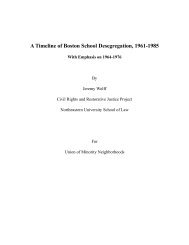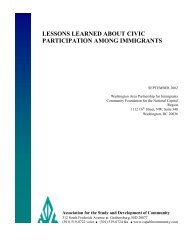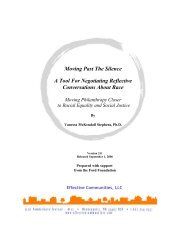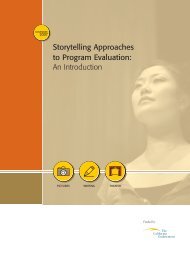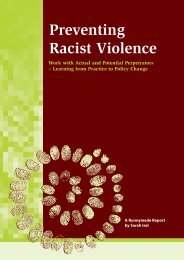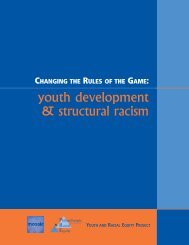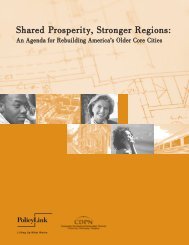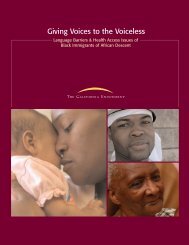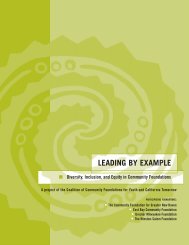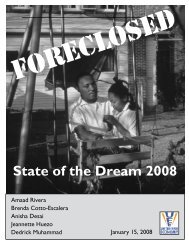REGIONAL OPPORTUNITYCalifornia when we’ve had an opportunity <strong>of</strong> thisscale. If the 80 percent <strong>of</strong> jurisdictions without an<strong>in</strong>clusionary policy adopted even a moderate<strong>in</strong>clusionary requirement, California couldpotentially <strong>in</strong>crease its production <strong>of</strong> affordablehous<strong>in</strong>g by as much as 35 to 50 percent. That meanshomes for Bay Area work<strong>in</strong>g families, our firefighters<strong>and</strong> nurses, <strong>and</strong> seniors on fixed <strong>in</strong>comes.”Doug Shoemaker, NPH’s deputy director agrees,add<strong>in</strong>g, “Many social equity groups struggle to f<strong>in</strong>d aregional campaign hook that works around l<strong>and</strong> use<strong>and</strong> affordable hous<strong>in</strong>g because these decisions arealmost always made“Many social equity groupsstruggle to f<strong>in</strong>d a regionalcampaign hook that worksaround l<strong>and</strong> use <strong>and</strong>affordable hous<strong>in</strong>g becausethese decisions are almostalways made at the locallevel. The key for policygroups is to recognize thatthese types <strong>of</strong> advocacynetworks can’t start <strong>and</strong> endwith one campaign. Theyneed to be thought <strong>of</strong> ascentral to the long-term<strong>in</strong>frastructure <strong>of</strong> theaffordable hous<strong>in</strong>g <strong>and</strong>social justice movement.”— Doug Shoemakerat the local level.The key for policygroups is torecognize that thesetypes <strong>of</strong> advocacynetworks can’t start<strong>and</strong> end with onecampaign. Theyneed to be thought<strong>of</strong> as central to thelong-term<strong>in</strong>frastructure <strong>of</strong> theaffordable hous<strong>in</strong>g<strong>and</strong> social justicemovement.”At the regional level,the Bay AreaInclusionaryHous<strong>in</strong>g Initiativewill focus onprovid<strong>in</strong>g tra<strong>in</strong><strong>in</strong>g,peer support, policy analysis, <strong>and</strong> communications tolocal governmental <strong>of</strong>ficials <strong>and</strong> communityadvocates. Efforts on the local level will focus ongrassroots organiz<strong>in</strong>g, technical assistance, <strong>and</strong>advocacy targeted to key jurisdictions.Funder InterestAt a fall 2003 regional meet<strong>in</strong>g <strong>of</strong> Bay Area funders<strong>in</strong>terested <strong>in</strong> hous<strong>in</strong>g, participants voiced a sharedconcern to exam<strong>in</strong>e smarter growth strategies <strong>and</strong>hous<strong>in</strong>g more closely. Accord<strong>in</strong>g to Cass<strong>and</strong>raBenjam<strong>in</strong>, senior program <strong>of</strong>ficer with the Charles<strong>and</strong> Helen Schwab Foundation, a number <strong>of</strong> fundersreadily agreed that policy work <strong>and</strong> IZ were projectprospects. Rather than follow the traditional approach<strong>in</strong> which funders identify priority areas, set criteria,<strong>and</strong> then review competitive proposals, this Initiativelaunched a collaborative process that engaged bothfunders <strong>and</strong> community groups <strong>in</strong> its conception.“We can see a real benefit to this approach,”observes Benjam<strong>in</strong>. “Our collaborative process <strong>and</strong>clear objectives have established a model for regionalcollaboration on a project with tangible goals.Hopefully, this is only the first project <strong>and</strong> otherswill follow.”For the Fannie Mae Foundation, the nation’s largestfoundation dedicated to affordable hous<strong>in</strong>g, therewas an early recognition <strong>of</strong> the need to connectsmarter growth strategies <strong>and</strong> hous<strong>in</strong>g more closely.“We understood concentrated support,” observesVera de Vera, director <strong>of</strong> Fannie Mae Foundation’sWestern <strong>Regional</strong> Office. “The question was what isthe best way we could come together to make afund<strong>in</strong>g impact. The key was to work withcommunity groups to ref<strong>in</strong>e issues <strong>and</strong> concerns.When we reconvened <strong>in</strong> the spr<strong>in</strong>g <strong>of</strong> 2004, weidentified IZ. But we were also <strong>of</strong>fered a plan thatwas outcome-driven.”The collaborative conceptualization among funders<strong>and</strong> community organizations was also supportedby research <strong>and</strong> statistics from NPH <strong>and</strong> the League<strong>of</strong> California Cities. Accord<strong>in</strong>g to Schwab’sBenjam<strong>in</strong>, “The really bad economic times made iteasier for government to buy-<strong>in</strong> to the project. Butthe <strong>in</strong>itial success was to take advantage <strong>of</strong>relationships. This project happened more as apartnership than as someth<strong>in</strong>g hierarchical.”Speak<strong>in</strong>g for the Pen<strong>in</strong>sula CommunityFoundation, its president, Sterl<strong>in</strong>g Speirn, expla<strong>in</strong>s,“Our foundations chose to support <strong>in</strong>clusionaryhous<strong>in</strong>g because it is an affordable hous<strong>in</strong>g strategywith demonstrated success <strong>in</strong> provid<strong>in</strong>g muchneeded low- <strong>and</strong> moderate-<strong>in</strong>come hous<strong>in</strong>g.”<strong>Regional</strong>/Neighborhood Equity ImpactsAccord<strong>in</strong>g to NPH’s Shoemaker, “California cities<strong>and</strong> counties are at the forefront <strong>of</strong> an <strong>in</strong>novativeaffordable hous<strong>in</strong>g practice that is benefit<strong>in</strong>gthous<strong>and</strong>s <strong>of</strong> households. Compell<strong>in</strong>g trends revealthat over the next few years, the number <strong>of</strong>California communities adopt<strong>in</strong>g <strong>in</strong>clusionaryzon<strong>in</strong>g practices for affordable hous<strong>in</strong>g is likely tocont<strong>in</strong>ue at a rapid pace.”93Funders’ Network for Smart Growth <strong>and</strong> Livable Communities
A new report from the National Hous<strong>in</strong>gConference entitled, Inclusionary Zon<strong>in</strong>g: TheCalifornia Experience, bolsters Shoemaker’s views.From 1994 to 2003, there was a 67 percent<strong>in</strong>crease <strong>in</strong> communities that adopted <strong>in</strong>clusionaryzon<strong>in</strong>g policies, from 64 to 107 communities. Inthe Bay Area, 60 <strong>of</strong> the area’s 109 jurisdictionscurrently have an exist<strong>in</strong>g IZ policy. Shoemakeradds, “Ultimately focus<strong>in</strong>g on the possibility for<strong>and</strong> benefits <strong>of</strong> <strong>in</strong>clusionary hous<strong>in</strong>g is morecritical than ever s<strong>in</strong>ce the fund<strong>in</strong>g <strong>of</strong> otheraffordable hous<strong>in</strong>g programs is be<strong>in</strong>g threatened bya tighten<strong>in</strong>g federal budget. In particular, with<strong>in</strong>the FY 2005 budget proposal, fund<strong>in</strong>g for Section8 hous<strong>in</strong>g vouchers is much lower than what isneeded to fund all contract renewals under currentprogram rules. The budget proposal also elim<strong>in</strong>atesthe successful HOPE VI program, which helps toreplace distressed public hous<strong>in</strong>g with mixed<strong>in</strong>come communities.”A former East Palo Alto City Council Member,Duane Bay, also notes the current fiscal climate.“Inclusionary zon<strong>in</strong>g is a commonsense answer tocreat<strong>in</strong>g hous<strong>in</strong>g that actually meets certa<strong>in</strong> needs <strong>of</strong>the community,” says Bay. “One <strong>of</strong> its primaryadvantages is that it does not require a large<strong>in</strong>vestment—or <strong>in</strong> some <strong>in</strong>stances, any f<strong>in</strong>ancial<strong>in</strong>vestment at all—by local governments. Anotheradvantage is that it helps to <strong>in</strong>tegrate those withdifferent ethnic <strong>and</strong> f<strong>in</strong>ancial backgrounds. Thecommunities themselves benefit from this <strong>in</strong>tegrationbecause <strong>of</strong> the need for both a low- <strong>and</strong> moderate<strong>in</strong>comeworkforce.”cities adopt or revise IZ programs, work<strong>in</strong>g with ourcampaign partners <strong>and</strong> governmental <strong>of</strong>ficials, wecan take thoseexamples <strong>and</strong> sharewith communitiesacross the country.”Lessons LearnedFrom the FannieMae Foundation’sperspective, one <strong>of</strong>the greatest lessonswas learn<strong>in</strong>g to be“not tooprescriptive,”“If cities adopt or revise IZprograms, work<strong>in</strong>g with ourcampaign partners <strong>and</strong>governmental <strong>of</strong>ficials, wecan take those examples<strong>and</strong> share with communitiesacross the country.”— Vera de Veraaccord<strong>in</strong>g to de Vera. “It was most beneficial to firstlisten to our community partners <strong>and</strong> then ask themto prioritize their concerns. Also, some fundersthought the campaign was too much advocacy. Animprovement would be to specifically def<strong>in</strong>e ‘policywork’ as awareness <strong>and</strong> education. Everyone wantedpolicymakers to be better educated on these issues.”From the community partner perspective,recogniz<strong>in</strong>g the <strong>in</strong>dependent nature <strong>of</strong> its membersalso meant a range <strong>of</strong> prior <strong>in</strong>terests. And thatrecognition translated <strong>in</strong>to policy negotiations. “Ourgoal,” said Shoemaker, “was gett<strong>in</strong>g <strong>in</strong>clusionaryhous<strong>in</strong>g outcomes <strong>and</strong> base-build<strong>in</strong>g outcomes. Thatk<strong>in</strong>d <strong>of</strong> regionalism worked—speak<strong>in</strong>g <strong>and</strong> learn<strong>in</strong>gfrom one another. As <strong>in</strong>dividual groups we had atremendous capacity.”ResultsFor the Schwab Foundation, this collaborativeapproach had to first recognize that each funderbrought to the discussion its own set <strong>of</strong> limitations.“We had silo targets,” expresses Benjam<strong>in</strong>. “Some <strong>of</strong>us had silos <strong>of</strong> target populations or geography. Butour goal <strong>of</strong> broad impact was respectful <strong>of</strong> eachfunder. And we knew we were hop<strong>in</strong>g to leverageorganizational names <strong>and</strong> status to elevate policyreform.” Benjam<strong>in</strong> adds, “If more citizens adoptreforms, IZ will be seen as the norm. It won’t be apanacea; but it will result <strong>in</strong> more <strong>in</strong>tegratedopportunities for low- <strong>and</strong> moderate-<strong>in</strong>comehouseholds.” The Fannie Mae Foundation furtherexp<strong>and</strong>s that same view with de Vera stat<strong>in</strong>g that, “IfREGIONAL OPPORTUNITYPart III: Section 3: Connect<strong>in</strong>g to <strong>Regional</strong> Opportunity 94
- Page 1 and 2:
Stories of Philanthropic Leadership
- Page 3 and 4:
Signs of Promise:Stories of Philant
- Page 5 and 6:
Funders’ Network for Smart Growth
- Page 7 and 8:
(II. B.)(II. C.)Turning Neighborhoo
- Page 9 and 10:
PART I:IntroductionThe Purpose of t
- Page 11 and 12:
social justice issues as they relat
- Page 13 and 14:
PART II:Perspectives on Advancing R
- Page 15 and 16:
peer work, we can reestablish a sig
- Page 17 and 18:
Annie E. Casey FoundationBaltimore,
- Page 19 and 20:
neighborhoods into healthy ones—g
- Page 21 and 22:
Charles and Helen Schwab Foundation
- Page 23 and 24:
Section 1:Promoting Equitable Publi
- Page 25 and 26:
I. A. BUILDING POWER AND GIVINGVOIC
- Page 27 and 28:
policy advocates. In 2002, Milwauke
- Page 29 and 30:
in Los Angeles, Ford’s Anthony no
- Page 31 and 32:
I. B. PROMOTING COALITIONSTO ADVANC
- Page 33 and 34:
Yet the interpersonal dynamics of c
- Page 35 and 36:
guidelines. “Many of the member o
- Page 37 and 38:
Funder InterestThe EPA supported th
- Page 39 and 40:
I. D. DEMONSTRATING THESTRUGGLE FOR
- Page 41 and 42:
Richmond, Calif.The second regional
- Page 43 and 44:
through policy reform at the local
- Page 45 and 46:
I. E. BUILDING COALITIONTHROUGH KNO
- Page 47 and 48:
organizing project, the Connecticut
- Page 49 and 50: and businesses are quantified in a
- Page 51 and 52: I. G. REVITALIZING WHILEASSURING DI
- Page 53 and 54: In the late 1990s, the city of Albu
- Page 55 and 56: I. H. A TRAVEZ DE LA FRONTERA:LAND
- Page 57 and 58: The International Community Foundat
- Page 59 and 60: I. I. MOBILIZING ACTION FORREGIONAL
- Page 61 and 62: To meet all of these objectives, th
- Page 63 and 64: efforts. And with each public plann
- Page 65 and 66: pattern of disproportionate transpo
- Page 67 and 68: Clinica de la Raza identify this cr
- Page 69 and 70: Contact PeopleCarl AnthonyActing Di
- Page 71 and 72: Section 2:Making All Neighborhoods
- Page 73 and 74: II. A. REACHING BEYONDHOUSING TO IM
- Page 75 and 76: A local resident receives the keys
- Page 77 and 78: East Baltimore community and the Jo
- Page 79 and 80: example, adjacent to the EBDI area,
- Page 81 and 82: II. C. YIELDING REGIONALBENEFITS TH
- Page 83 and 84: is using transit-oriented developme
- Page 85 and 86: financing and innovative, forward-t
- Page 87 and 88: The Row House Community Development
- Page 89 and 90: II. E. COUNTERING THE PERFECTSTORM:
- Page 91 and 92: funded community programs, includin
- Page 93 and 94: housing developments and commercial
- Page 95 and 96: owned enterprises, totaling $8.5 mi
- Page 97 and 98: LOAN GUARANTEESSection 3:Connecting
- Page 99: III. A. MAKING HOUSING ANOPPORTUNIT
- Page 103 and 104: The Straphangers Campaign was found
- Page 105 and 106: Funder InterestThe Straphangers Cam
- Page 107 and 108: or increase poverty. Whether direct
- Page 109 and 110: The Regional Plan Association then
- Page 111 and 112: multi-stakeholder effort composed o
- Page 113 and 114: director with LISC. No one set of s
- Page 115 and 116: 12 western Louisville neighborhoods
- Page 117 and 118: III. E. UNITING THREE STATESFOR ONE
- Page 119 and 120: increased their personal wealth by
- Page 121 and 122: summary evaluation of MSDI found th
- Page 123 and 124: method alone was strong enough to m
- Page 125 and 126: consistent body of work. The Counci
- Page 127 and 128: 3) Issues Need to be ConnectedThe f
- Page 129 and 130: PART V:Glossary of TermsThe terms d
- Page 131 and 132: Regional and neighborhood equity. A
- Page 133 and 134: Tijuana River Reserve, California:h
- Page 135 and 136: Sargent Shriver National Center on
- Page 137: 1500 San Remo Avenue • Suite 249



